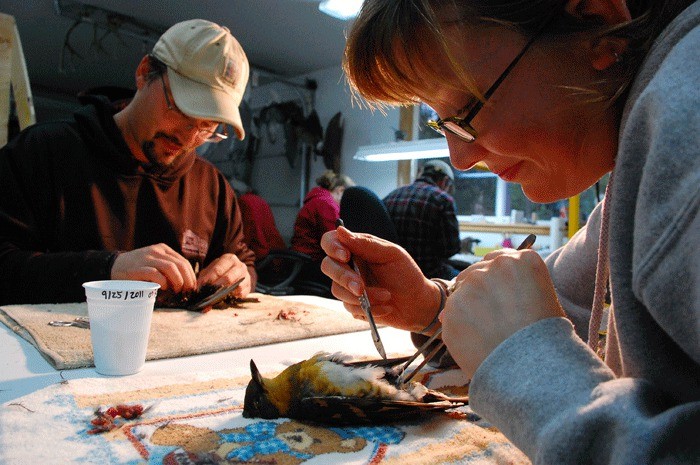A bird in the hand is worth … well, it’s worth a trip to Greenbank Farm. Especially since “Zeb” the hawk will be there.
Whidbey Audubon Society members have been working hard with professional taxidermist Matt Klope preparing specimens for hands-on examination at “Bird in Hand — the Grand Finale” from 7 to 9 p.m. Thursday, June 14 at Greenbank Farm.
After a year of various programs that focus on stewardship and education, the Whidbey Audubon Society ends its season with an exciting opportunity for the whole family. Bird in Hand allows bird lovers to get an up close and personal look at the wide variety of the birds on Whidbey Island. Participants can touch the taxidermied birds and have the experience of what a Great Horned Owl’s feathers feel like, or the feel of a raptor’s talons.
“What I enjoy most is being able to see birds really up close to where you can actually see feather patterns, feet and bills or beaks;” Klope said, “the things you just can’t see through a spotting scope.”
On hand will be more than 400 specimens of the full gamut of island birds, from passerines and raptors to all the seabirds and shore birds, ducks, geese and others.
Bird in Hand will allow young and old alike to study closely the bird specimens that have been carefully preserved by hard working volunteers under the tutelage of Klope.
Klope is a U.S. Naval wildlife biologist and owner of Whidbey Island Taxidermy. He started the collection.
“Matt has a taxidermy permit from the Department of Fish and Wildlife, which allows him to be in possession of the expired birds,” said Whidbey Audubon Society member Robin Llewellyn, one of the organizers of the event.
“A number of the birds also belong to the Whidbey Audubon Society which holds a Fish and Wildlife Salvage permit through Sarah Schmidt, past president of the Whidbey Audubon Society,” Llewellyn added.
Being able to see the delicate feathers is the best way to learn to identify birds and to admire their beauty,” Llewellyn said. “Some of the most beautiful colors and patterns found in nature are found on birds,” she said.
Klope said the shorebirds are one of his favorites.
“I think the shorebirds are pretty cool because their plumages change so much throughout the year,” he said.
Besides the feather patterns and colors, the program also gives folks a chance to see the beaks, wings, tails, eyes, feet and the owls’ ears.
Everyone is welcome to come to the open house event at the big red barn on the farm where society members will answer questions and offer interesting facts about the birds. A powerful microscope and magnifiers will also be available to observe the feather structure of the birds.
“Looking at the feathers of an owl demonstrates just how these birds are able to fly without making a sound,” Llewellyn said.
Klope’s flock of specimen preparers includes Tillie Scruton, Sarah Schmidt, Lisa Harkins, Janet Stein, Oz Allen, Dan Klope and Sarah Templin, who in the course of the past two years, have painstakingly turned dead birds into learning tools.
“The Audubon members have been so good at collecting and correctly labeling birds, that any extras we get are sent to the Division of Birds, National Museum of Natural History, Smithsonian Institution,” Klope said. “So, many of the members have their names on a specimen at the Smithsonian. That is very cool,” he added.
“This hands on experience is very educational and lets us all know more about the curious world of birds around us,” Llewellyn said.
As a special guest, the society is honored to welcome Julia Parrish, or one of the members of her Coastal Observation and Seabird Survey Team (COASST) team from the University of Washington, to answer any questions about seabirds.
Falconer Dr. Mark Borden will also be present, accompanied by his living Harris hawk, “Zeb.”
The event is free and open to the public.



